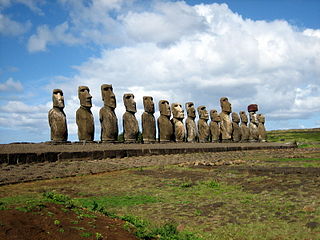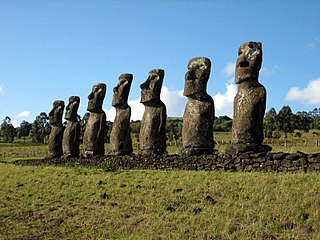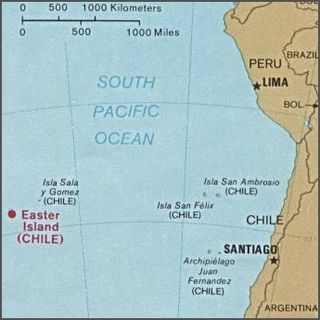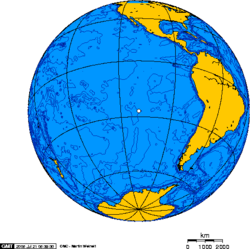
Easter Island is an island and special territory of Chile in the southeastern Pacific Ocean, at the southeasternmost point of the Polynesian Triangle in Oceania. The island is renowned for its nearly 1,000 extant monumental statues, called moai, which were created by the early Rapa Nui people. In 1995, UNESCO named Easter Island a World Heritage Site, with much of the island protected within Rapa Nui National Park.

Moai or moʻai are monolithic human figures carved by the Rapa Nui people on Rapa Nui in eastern Polynesia between the years 1250 and 1500. Nearly half are still at Rano Raraku, the main moai quarry, but hundreds were transported from there and set on stone platforms called ahu around the island's perimeter. Almost all moai have overly large heads, which account for three-eighths of the size of the whole statue. They also have no legs. The moai are chiefly the living faces of deified ancestors.

Rano Raraku is a volcanic crater formed of consolidated volcanic ash, or tuff, and located on the lower slopes of Terevaka in the Rapa Nui National Park on Easter Island in Chile. It was a quarry for about 500 years until the early eighteenth century, and supplied the stone from which about 95% of the island's known monolithic sculptures (moai) were carved. Rano Raraku is a visual record of moai design vocabulary and technological innovation, where 887 moai remain. Rano Raraku is in the World Heritage Site of Rapa Nui National Park and gives its name to one of the seven sections of the park.

Katherine Maria Routledge was an English archaeologist and anthropologist who, in 1914, initiated and carried out much of the first true survey of Easter Island.

Rapa-Nui is a 1994 American historical action-adventure film directed by Kevin Reynolds and co-produced by Kevin Costner, who starred in Reynolds's previous film, Robin Hood: Prince of Thieves (1991). The plot is based on Rapa Nui legends of Easter Island, Chile, in particular the race for the sooty tern's egg in the Birdman Cult.

The Tangata manu was the winner of a traditional ritual competition on Rapa Nui to collect the first sooty tern egg of the season from the nearby islet of Motu Nui, swim back to Rapa Nui, and climb the sea cliffs of Rano Kau to the clifftop village of Orongo.

Rapa Nui National Park is a national park and UNESCO World Heritage Site located on Easter Island, Chile. Rapa Nui is the Polynesian name of Easter Island; its Spanish name is Isla de Pascua. The island is located in the southeastern Pacific Ocean, at the southeastern extremity of the Polynesian Triangle. The island was taken over by Chile in 1888. Its fame and World Heritage status arise from the 887 extant stone statues known by the name "moai", whose creation is attributed to the early Rapa Nui people who inhabited the island starting between 300 and 1200 AD. Much of the island has been declared as Rapa Nui National Park which, on 22 March 1996, UNESCO designated a World Heritage Site under cultural criteria (i), (iii), & (v). Rapa Nui National Park is now under the administrative control of the Ma´u Henua Polynesian Indigenous Community, which is the first autonomous institute on the island. The indigenous Rapa Nui people have regained authority over their ancestral lands and are in charge of the management, preservation and protection of their patrimony. On the first of December 2017, the ex-President Michelle Bachelet returned ancestral lands in the form of the Rapa Nui National Park to the indigenous people. For the first time in history, the revenue generated by the National Park is invested in the island and used to conserve the natural heritage.
Hotu Matuꞌa was the legendary first settler and ariki mau of Easter Island and ancestor of the Rapa Nui people. Hotu Matuꞌa and his two-canoe colonising party were Polynesians from the now unknown land of Hiva. They landed at Anakena beach and his people spread out across the island, sub-divided it between clans claiming descent from his sons, and lived for more than a thousand years in their isolated island home at the southeastern tip of the Polynesian Triangle.

Rapa Nui mythology, also known as Pascuense mythology or Easter Island mythology, refers to the native myths, legends, and beliefs of the Rapa Nui people of Easter Island in the south eastern Pacific Ocean.

The Hanau epe were a semi-legendary people who are said to have lived in Easter Island, where they came into conflict with another people known as the Hanau momoko or "short-ears". A decisive battle occurred which led to the defeat and extermination of the Hanau epe. According to the legend, these events are supposed to have happened at some point between the 16th and 18th centuries, probably in the late 17th century.

Anakena is a white coral sand beach in Rapa Nui National Park on Rapa Nui, a Chilean island in the Pacific Ocean. Anakena has two ahus; Ahu-Ature has a single moai and Ahu Nao-Nao has seven, two of which have deteriorated. It also has a palm grove and a car park.

Ahu Tongariki is the largest ahu on Easter Island. Its moais were toppled during the island's civil wars, and in the twentieth century the ahu was swept inland by a tsunami. It has since been restored and has fifteen moai, including one that weighs eighty-six tonnes, the heaviest ever erected on the island. Ahu Tongariki is one kilometer from Rano Raraku and Poike in the Hotu-iti area of Rapa Nui National Park. All the moai here face sunset during the winter solstice.

Ahu Akivi is a particular sacred place on the Chilean island of Rapa Nui, looking out towards the Pacific Ocean. The site has seven moai, all of equal shape and size, and is also known as a celestial observatory that was set up around the 16th century. The site is located inland, rather than along the coast. Moai statues were considered by the early people of Rapa Nui as their ancestors or Tupuna that were believed to be the reincarnation of important kings or leaders of their clans. The Moais were erected to protect and bring prosperity to their clan and village.

Geologically one of the youngest inhabited territories on Earth, Easter Island, located in the mid-Pacific Ocean, was, for most of its history, one of the most isolated. Its inhabitants, the Rapa Nui, have endured famines, epidemics of disease, civil war, environmental collapse, slave raids, various colonial contacts, and have seen their population crash on more than one occasion. The ensuing cultural legacy has brought the island notoriety out of proportion to the number of its inhabitants.

Hotu-iti is an area of southeastern Easter Island that takes its name from a local clan. Located in Rapa Nui National Park, the area includes Rano Raraku crater, the Ahu Tongariki site, and a small bay. In the 15th and 16th centuries, the Hotu-iti clan was one of two polities on Easter Island.

Siméon or Timeone Riro ʻa Kāinga Rokoroko He Tau was the last ‘ariki (king) of Rapa Nui from 1892 until his death. He ruled the island during a brief period of indigenous autonomy between Chile's initial annexation in 1888 and the country's reassertion of colonial authority in 1896. Riro died unexpectedly during a diplomatic trip to Chile to discuss the island's sovereignty with colonial authorities, leading to suspicions that he had been poisoned.

Atamu Tekena or Atamu te Kena, full name Atamu Maurata Te Kena ʻAo Tahi was the penultimate ‘Ariki or King of Rapa Nui from 1883 until his death. In 1888, he signed a treaty of annexation ceding Easter Island to Chile in a ceremony officiated by Captain Policarpo Toro. His name is translated as "Adam the Gannet".
Valentino Riroroko Tuki was a claimant to the Rapa Nui throne of Easter Island. He was the grandson of the last King Simeón Riro Kāinga, who died in 1899 and belonged to the Miru clan, descendants of the founder and first Ariki Mau of Rapa Nui, the legendary Hotu Matua.
Moisés Jacob Tu‘u Hereveri was elected ‘ariki (king) of Rapa Nui from 1901 until 1902. He was the last Rapa Nui to claim the traditional kingship in the early 20th-century. However, he is not remembered as the last king instead his predecessor Riro Kāinga is generally regarded as the last king, although neither held much power. Variation of his family name included Hereveri, Here Veri, Veri-Veri, Beri-Beri, Tueri-Beri, Tueriveri, or Tueriveri.
Enrique Ika a Tuʻu Hati was elected ‘ariki (king) of Rapa Nui in 1900 and led a failed rebellion. He was one of the last Rapa Nui to claim the traditional kingship in the early 20th-century. However, he is not remembered as the last king; instead his predecessor Riro Kāinga is generally regarded as the last king, although neither held much power.



















